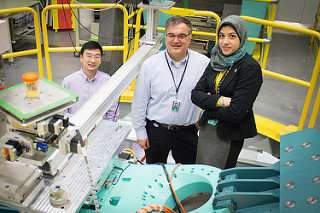Bright light allows researchers to see bone as well as tissue
![A sample computer model derived from synchrotron radiation phase-contrast (SR-PC) images of the human middle ear. (a) Illustrates 3D model of the middle ear including the tympanic membrane (TM), middle-ear ossicles (malleus, incus and stapes) and soft tissue structures [tensor tympani muscle (TTM), incudostapedial joint (ISJ), stapedial annular ligament (SAL), stapedius muscle (SM), posterior incudal ligament (PIL), incudomalleolar joint (IMJ), lateral malleolar ligament (LML) and anterior mallear ligament (AML)]. (b) A sample plane through the model showing the corresponding SR-PC image slice with model boundaries superimposed. Note the distinctive sharpness of the soft tissues and the adjacent bones. The spatial location of this plane is given in the top right corner. Images courtesy of Hanif Ladak. Credit: Canadian Light Source Bright light allows researchers to see bone as well as tissue](https://scx1.b-cdn.net/csz/news/800a/2018/5a4cbbe0822e3.jpg)
Getting good images of the middle ear and all its parts is tricky. But it's needed for scientists who want to do things like repair damage or make devices to help aging middle ears function better.
According to the Canadian Health Measures Survey, about 20 per cent of adults aged 19 to 79 years have at least mild hearing loss in at one or both ears, while close to 47 per cent of adults aged 60 to 79 years have some level of hearing loss. Damage to the middle ear is a common contributor to hearing loss.
There are several challenges to getting good images of the middle ear, especially 3D images, according to Hanif Ladak, a professor of biomedical engineering at Western University.
For one, the three bones that make up the middle ear are small, measuring only a few millimeters across. But there are even tinier soft-tissue structures that connect the bones and allow them to function. This includes ligaments, muscle and nerves which in turn are measured in micrometers – about 100 times smaller than the width of a hair.
Detailed 3D images of all the parts together are needed in order to design prostheses or implants, he said. To date, many places have devices which can generate 3D images of the bone, but don't capture the soft tissues.
This is where the Canadian Light Source came in. The researchers took complete middle ears from cadavers and placed them into chambers in the synchrotron. They were then bombarded with X-rays which basically bounced off the different parts of the samples at different rates. Data relating to the behavior of the X-rays was used to build digital 3D images.

"The CLS let us successfully image both the bone and soft tissue," he said.
Now, work can start on designing and building better implants and prostheses to help with hearing problems related to the middle ear.
In fact, 3D images from the work at CLS were so impressive, they were placed on the cover of the peer-reviewed scientific journal Hearing Research which is read by people in the hearing research community.
Ladak notes that having soft tissues captured in the imaging help elucidate how different parts of the middle ear move in relationship to each other and allow people to hear. Having that information in computer models will allow for the eventual development of new types of devices and approaches that can help with hearing problems.
At this point there have been meetings with some people from industry expressing interest in using this work, but it's too early to say what sorts of innovations may result.
In previous work, his team used the CLS to get more detailed images of another part of the ear: the cochlea. In that research, scientists were able to create a series of detailed maps, or atlas, of the cochlea that can be used by surgeons doing cochlear implant surgery – the implantation of a small electronic hearing device that helps profoundly deaf patients. The atlas helps improve the accuracy of the placement of implants, and can be used to help select the right size or length of implant.
More information: Mai Elfarnawany et al. Improved middle-ear soft-tissue visualization using synchrotron radiation phase-contrast imaging, Hearing Research (2017). DOI: 10.1016/j.heares.2017.08.001
Provided by Canadian Light Source

















